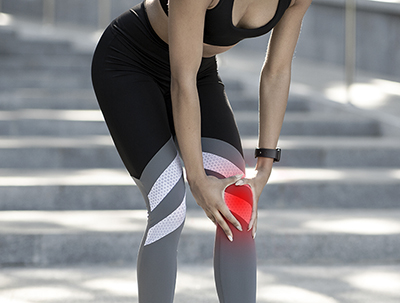
When someone refers to patellofemoral pain syndrome they are referring to pain at the front of the knee, around the kneecap. patellofemoral pain syndrome is sometimes, also, called runners knee. Typically this is more common in those who play sports that involve jumping or running.
Often, knee pain will increase when you walk up or down the stairs or when you run. However, sometimes if you sit for long periods of time or quat pain will also be present. Furthermore, conservative treatment methods, such as ice and rest, commonly help. Though physical therapy is also sometimes necessary for pain relief.
Symptoms of Patellofemoral Pain Syndrome
When someone experiences runners knee a dull, aching pain is common. Typically this pain is located at the front of the knee. Pain flare-ups are most common when you perform actions, such as:
- Walking up or down the stairs
- Kneeling or squatting
- Sitting with a bent knee for extended periods
What Causes Runners Knee?
- Muscle weaknesses or imbalances. The pain occurs when the muscles around your hip and knee don’t keep your kneecap properly aligned. Inward movement of the knee during a squat has been found to be associated with patellofemoral pain.
- Overuse. Running or jumping sports puts repetitive stress on your knee joint, which can cause irritation under the kneecap.
- Injury. Trauma to the kneecap, such as a dislocation or fracture, has been linked to this condition.
- Surgery. Knee surgery, particularly repair to the anterior cruciate ligament using your own patellar tendon as a graft, increases the risk of the syndrome.
Treatment for Patellofemoral Pain Syndrome
Conservative methods are first considered for patellofemoral pain syndrome, such as:
Medications
Over-the-counter medications, such as acetaminophen (Tylenol, others), ibuprofen (Advil, Motrin IB, others,) or naproxen sodium (Aleve).
Therapy
Physical therapy is a common treatment method for patellofemoral pain syndrome. A physical therapist will typically suggest:
- Rehabilitation exercises. Specific exercises can strengthen the muscles that support your knees and control limb alignment, such as your quadriceps, hamstrings, and the muscles around your hips, especially hip abductors. Correcting the inward movement of the knee during squatting is a primary goal.
- Supportive braces. Knee braces or arch supports may help improve pain.
- Taping. Your physical therapist may show you how to tape your knee to reduce pain and enhance your ability to exercise.
- Ice. Icing your knee after exercise might be helpful.
- Knee-friendly sports. During your recovery, you may want to restrict yourself to low-impact activities that are easier on the knees — such as bicycling and swimming or water running.
When conservative methods fail for runners knee, surgical methods are then offered.
Surgical Methods for Runners Knee:
- Arthroscopy. During this procedure, the doctor inserts a pencil-thin device equipped with a camera lens and light (arthroscope) into your knee through a tiny incision. Surgical instruments are passed through the arthroscope to remove fragments of damaged cartilage.
- Realignment. In more severe cases, a surgeon may need to operate on your knee to realign the angle of the kneecap or relieve pressure on the cartilage.
If you are experiencing runners knee aka patellofemoral pain syndrome, call us at 888-409-8006.
